Took a solo trip up and down the Oswegatchie River to a few miles above the high falls. Oct 26th to 28th 2023. The popular area canoe guide says it is an 8 hour trip up river and 5 hours back down. For me it was about 5 hours up and 3 hours down.
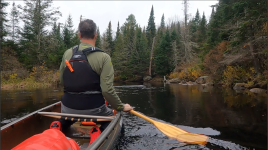
The first day I paddled from Inlet Road to camp 22 in a little over 4 hours this is about 12.5 miles upstream and about a mile away from the high falls. The water was a bit high for this trip and there was only one beaver dam I could not paddle over on this first day. I typically do not base camp but stayed at this location two nights. Turns out this was a good idea. Because of the up and back nature of the trip I would have camped in about the same location anyway, not loosing the time breaking down camp and setting up again worked out great especially since it rained 80 percent of the time. Also the river above campsite 22 had more obstacles in it and going over them in an empty canoe was a lot easier. An empty canoe was super easy to portage around high falls without all my kit. There was a nasty log jam that was hard to get over and it was the only obstacle I could not go over heading back down river.
The river is crazy bendy, going upstream I swear I went in a complete circle a few times. The current is a bit strong on a lot of the turns and it helps if you can be pointed in the right direction at the apex of the turn so you don't have to fight the current coming towards you as you are trying to turn into it.
The area around the river is all beaver ponds and bog up until about you hit the camp sites in the 20s. Most of the river bottom and banks are super soft sand, The banks are mostly lined with some grass and low scrub bushes. There are not really many good places to stop. I would think this would be prime black fly territory in the summer. I am glad it was cold enough where they were not out anymore for my trip. For this reason this may be a better shoulder season trip.
I made camp in the rain at site 22. Nice site room for a few tents and a it has a privy. The area around the fire pit was a bit worn-out and dirty but the rest was nice and clean.
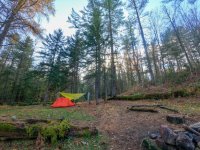
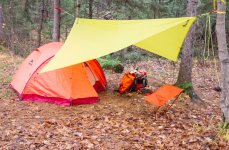
The second day I paddled up the river, in an empty boat, over quite a few beaver dams, log jams and a small rapid (that I failed to get up). I stopped at the High Falls for a bit and then portaged around them and padded up the river about an hour more. The portage is about a three minute walk and easy. Above the falls the river has more dams and log jams and the current seems a bit faster. With the rain starting again I did not go more than two miles up before turning around.
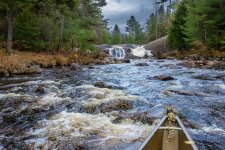
Downriver is SO much more fun than up I made it back to camp and the sun came out for a little while. Hung out at the river and had dinner.
I made it back to camp and the sun came out for a little while. Hung out at the river and had dinner.
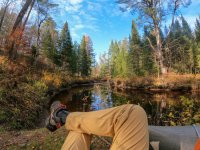
Woke up at dawn to strike the camp and head back down river to the car. It started raining almost immediately. I took down my wet camp and was on the river before 9am. The raining the wind picked up,I put my spray decks on canoe to keep some water out. I was in my semi dry top and pants and it was just cool enough outside were I did not feel hot or sweat, so the rain was not really an issue except for having to stop paddling every once in a while to use my bilge pump (sponge).
The trip back to Inlet road, from campsite 22 was about 2.5 hours. I packed the car and changed in the rain. The Inlet dirt road back to 3 is about three miles, while driving those three miles the rain stopped and the sun came out
Here is a link to a video log I made of the trip.

The first day I paddled from Inlet Road to camp 22 in a little over 4 hours this is about 12.5 miles upstream and about a mile away from the high falls. The water was a bit high for this trip and there was only one beaver dam I could not paddle over on this first day. I typically do not base camp but stayed at this location two nights. Turns out this was a good idea. Because of the up and back nature of the trip I would have camped in about the same location anyway, not loosing the time breaking down camp and setting up again worked out great especially since it rained 80 percent of the time. Also the river above campsite 22 had more obstacles in it and going over them in an empty canoe was a lot easier. An empty canoe was super easy to portage around high falls without all my kit. There was a nasty log jam that was hard to get over and it was the only obstacle I could not go over heading back down river.
The river is crazy bendy, going upstream I swear I went in a complete circle a few times. The current is a bit strong on a lot of the turns and it helps if you can be pointed in the right direction at the apex of the turn so you don't have to fight the current coming towards you as you are trying to turn into it.
The area around the river is all beaver ponds and bog up until about you hit the camp sites in the 20s. Most of the river bottom and banks are super soft sand, The banks are mostly lined with some grass and low scrub bushes. There are not really many good places to stop. I would think this would be prime black fly territory in the summer. I am glad it was cold enough where they were not out anymore for my trip. For this reason this may be a better shoulder season trip.
I made camp in the rain at site 22. Nice site room for a few tents and a it has a privy. The area around the fire pit was a bit worn-out and dirty but the rest was nice and clean.


The second day I paddled up the river, in an empty boat, over quite a few beaver dams, log jams and a small rapid (that I failed to get up). I stopped at the High Falls for a bit and then portaged around them and padded up the river about an hour more. The portage is about a three minute walk and easy. Above the falls the river has more dams and log jams and the current seems a bit faster. With the rain starting again I did not go more than two miles up before turning around.

Downriver is SO much more fun than up

Woke up at dawn to strike the camp and head back down river to the car. It started raining almost immediately. I took down my wet camp and was on the river before 9am. The raining the wind picked up,I put my spray decks on canoe to keep some water out. I was in my semi dry top and pants and it was just cool enough outside were I did not feel hot or sweat, so the rain was not really an issue except for having to stop paddling every once in a while to use my bilge pump (sponge).
The trip back to Inlet road, from campsite 22 was about 2.5 hours. I packed the car and changed in the rain. The Inlet dirt road back to 3 is about three miles, while driving those three miles the rain stopped and the sun came out
Here is a link to a video log I made of the trip.
